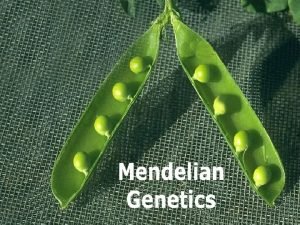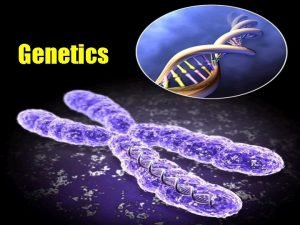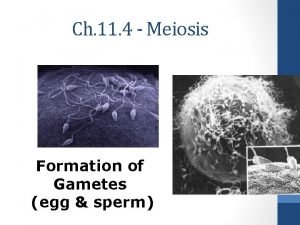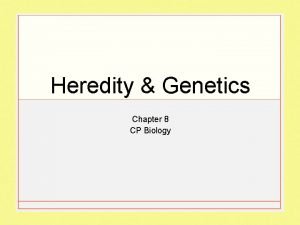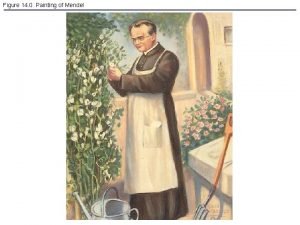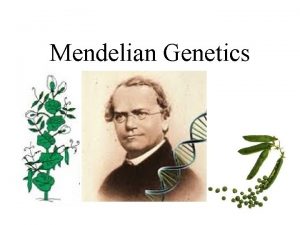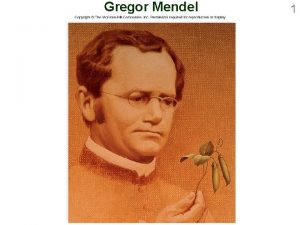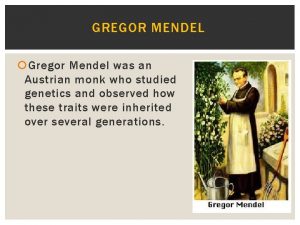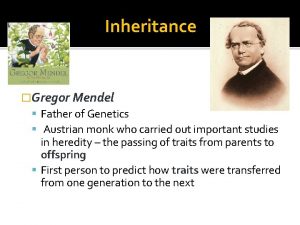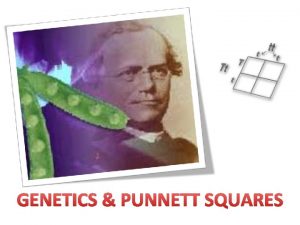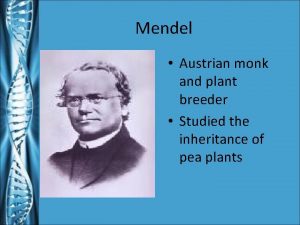Mendels Law of Segregation Georg Mendel Austrian monk














- Slides: 14

Mendel‘s Law of Segregation

Georg Mendel Austrian monk • born in 1822 • in monastery known for research and teaching • after his death (1884) acknowledgment of his discoveries in 1900

Experiments with Pea Plants - Seed coat colour (gray or white) - Seed shape (round or wrinkled) - Seed colour (yellow or green) - Pod colour (green or yellow) - Flower position (axial or terminal) - Pod shape (inflated or constricted) - Stem length (tall or dwarf)

Cross-Pollination of Purebread Plants - cross-pollination between true breeding green and yellow pods - all F 1 green F 1 Generation Gg = heterozygous

F 2 Generation - self-pollination of green F 1 plants - ¾ in F 2 green, ¼ yellow - 3 : 1 ratio in pod colour in F 2 G = dominant = green g = recessive = yellow GG, gg = homozygous

Seed Colour C = dominant = yellow c = recessive = green

Inheritance of Pea Colour phenotype: genotype:

Results from Mendel's Experiments F 1 Phenotype F 2 Phenotypic Ratio F 2 Ratio Round x Wrinkled Seed Round 5474 Round : 1850 Wrinkled 2. 96: 1 Yellow x Green Seeds Yellow 6022 Yellow : 2001 Green 3. 01: 1 Axial x Terminal Flower Position Axial 705 Axial : 224 Terminal 3. 15: 1 Tall x Dwarf Plants Tall l 787 Tall : 227 Dwarf 2. 84: 1 Parental Cross

Mendel‘s Generalization 1. Alternative versions of genes account for variations in inherited characters - concept of alleles (G=green, g=yellow) 2. For each character, an organism inherits two genes, one from each parent - two gametes form somatic cells - one allele comes from the mother, one from the father

Mendel‘s Generalization 3. If the two alleles differ, then: - dominant allele is fully expressed in the organism's appearance (phenotype) - recessive allele has no noticeable effect on the organism's appearance (genotype) 4. The two genes for each character segregate during gamete production - ensures variation

Law of Segregation • the pair of alleles of each parent separate and only one allele passes from each parent on to an offspring • which allele in a parent's pair of alleles is inherited is a matter of chance • segregation of alleles occurs during the process of gamete formation (meiosis) • randomly unite at fertilization

Mendel’s laws have their limitations. For example, if two genes are on the same chromosome, the assortment of their alleles will not be independent. Also, for genes found on the X chromosome, expression of the trait can be linked to the sex of the offspring. Our knowledge of genetics and the tools we use in its study have advanced a great deal since Mendel’s time, but his basic concepts still stand true.

• Drosophila melanogaster, the common fruit fly, has been used for genetic experiments since T. H. Morgan started his experiments in 1907. Drosophila make good genetic specimens because they are small, produce many offspring, have easily discernable mutations, have only four pairs of chromosomes, and complete their entire life cycle in about 12 days. They also have very simple food requirements. Chromosomes 1 (the X chromosome), 2, and 3 are very large, and the Y chromosome – number 4 – is extremely small. These four chromosomes have thousands of genes, many of which can be found in most eukaryotes, including humans.

• Differences in body features help distinguish between male and female flies. Females are slightly larger and have a light-colored, pointed abdomen. The abdomen of males will be dark and blunt. The male flies also have dark bristles, sex combs, on the upper portion of the forelegs.
 Austrian monk
Austrian monk Mendel
Mendel Austrian monk
Austrian monk Law of segregation meiosis
Law of segregation meiosis Mendels law of segregation states that
Mendels law of segregation states that Mendel's law of independent assortment and segregation
Mendel's law of independent assortment and segregation Was mendel a monk
Was mendel a monk Mendel monk
Mendel monk Law of segregation vs law of independent assortment
Law of segregation vs law of independent assortment Random assortment vs independent assortment
Random assortment vs independent assortment F
F What is codominance in biology
What is codominance in biology For the pedigree in figure 14-6
For the pedigree in figure 14-6 Mendel's first law
Mendel's first law Phenotype and genotype
Phenotype and genotype
